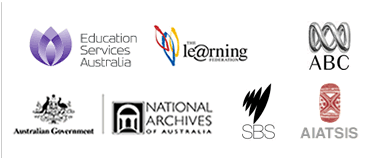This clip chosen to be PG
Clip description
The main characters are introduced: Joyce Clague, Gary Foley, and Chicka Dixon – all were present and instrumental in the creation of The Foundation.
Curator’s notes
In contemporary Australia, the association between Indigenous peoples and welfare dependency is quite a prominent belief. In this clip, we learn that Indigenous peoples up until very recently were in fact ineligible for welfare support, making the establishment of something like The Foundation necessary. We hear from key personalities involved in the empowerment of Indigenous peoples.
Teacher’s notes
provided by 

This clip shows interviews with Indigenous activists Joyce Clague, Gary Foley and Charles (Chicka) Dixon who explain the role of the Foundation for Aboriginal Affairs in pushing for greater autonomy and economic independence for Indigenous Australians and the social and political situation in the early 1960s, including the government’s policy of assimilation. Music and sound effects are used in the clip and the interviews are intercut with black-and-white historical footage and photographs.
Educational value points
- The Foundation for Aboriginal Affairs, established in 1963 in Sydney, agitated for political and social change and supported Aboriginal people – particularly young rural people moving to Sydney. The main forms of support were accommodation, employment, legal and financial advice and medical assistance.
- As a result of the massive fundraising appeal of 1964 mentioned in the clip, the Foundation bought a building in George Street, Sydney and established meeting rooms, a gymnasium, counselling services, adult education, a hostel and accommodation. By 1967 more than 400 people were using the services and by 1973 an all-Indigenous management was in place.
- In this clip Joyce Clague discusses how in the early 1960s most Aboriginal Australians were unable to receive unemployment benefits, the pension or child endowment. In the mid-20th century many Indigenous people were still forced to live on missions, lacked the right of free movement and were unable to vote.
- Indigenous Australians were able to apply for a Citizenship Certificate or Certificate of Exemption, which required that, among other things, they kept away from other Aboriginal people and lived a Western lifestyle. In return they could vote, they were allowed into hotels and their children could go to school.
- The policy of assimilation, mentioned by Gary Foley in this clip, was officially adopted as national policy in 1937 and remained so until 1972. By 1951 all state governments claimed that they had adopted this policy but it was not until 1961 that a definition of what assimilation actually meant was agreed on.
- The definition of assimilation agreed on in 1961 stated: 'The policy of assimilation means that all Aborigines and part-Aborigines are expected eventually to attain the same manner of living as other Australians and to live as members of a single Australian community enjoying the same rights and privileges, accepting the same responsibilities, observing the same customs and influenced by the same beliefs, as other Australians.’
- Assimilation had various shades of meaning. To some advocates it meant compulsory absorption and disappearance of the Indigenous peoples. To others, it meant equal rights and integration by choice with the non-Indigenous population. Government rhetoric gradually shifted to the latter view. At the time, few whites comprehended that the First Australians might prefer to retain their own culture, or that neutral laws do not deliver equality in fact.
- Gary Foley (1950–) grew up in northern NSW and is of Gumbainggir descent. In the 1960s he became involved in Indigenous political activism and co-founded the Tent Embassy in Canberra in 1972. He was also involved in the formation of Redfern’s Aboriginal Legal Centre and of Aboriginal Medical Services in Sydney and Melbourne. Foley is a playwright, actor, former curator at Museum Victoria and currently a lecturer at the University of Melbourne.
This clip starts approximately 1 minute into the documentary.
Indigenous activists Joyce Clague, Gary Foley and Charles ‘Chicka’ Dixon explain the role of the Foundation for Aboriginal Affairs in the1960s, including the government’s policy of assimilation. The interviews are intercut with black-and-white historical footage and photographs.
Joyce Clague The Foundation was an organisation. OK, they said it was a non-sectarian and non-political. But I tell you what, there was a lot of politics in it as well.
Gary Foley The Foundation for Aboriginal Affairs played a crucial role as the crucible, if you like, that nurtured the, the, the great move and push for Aboriginal community control and Aboriginal economic independence.
Charles ‘Chicka’ Dixon It taught people to stand up and by counted, really. You couldn’t help it, with the likes of me and Charlie Perkins there hammering them all the time to be proud of what they are and stand up and be counted.
Title card: The Foundation, 1963-1977.
Joyce There were a lot of things wrong in the Australian society of that day that needed changing. Many of the Aboriginal people that were living in the country, it was seasonal work, picking potatoes, beans or whatever. They had to find other jobs because we couldn’t get the dole, we couldn’t have the pension and even my mother wasn’t – they said that she couldn’t handle money. So they didn’t give her money, such as the child endowment.
Gary White racism was still all powerful. The main notions in mainstream society about Aborigines involved assimilation. Assimilation was still very much regarded as being the answer to the Aboriginal problems. So Aboriginal people’s personal and cultural values were very much under attack on a day-to-day basis.
Thanks to the generosity of the rights holders, we are able to offer In the beginning from the documentary The Foundation 1963–1977 as a high quality video download.
To play the downloadable video, you need QuickTime 7.0, VLC, or similar.
You must read and agree to the following terms and conditions before downloading the clip:
australianscreen is produced by the National Film and Sound Archive. By using the website you agree to comply with the terms and conditions described elsewhere on this site. The NFSA may amend the 'Conditions of Use’ from time to time without notice.
All materials on the site, including but not limited to text, video clips, audio clips, designs, logos, illustrations and still images, are protected by the Copyright Laws of Australia and international conventions.
When you access australianscreen you agree that:
- You may retrieve materials for information only.
- You may download materials for your personal use or for non-commercial educational purposes, but you must not publish them elsewhere or redistribute clips in any way.
- You may embed the clip for non-commercial educational purposes including for use on a school intranet site or a school resource catalogue.
- The National Film and Sound Archive’s permission must be sought to amend any information in the materials, unless otherwise stated in notices throughout the Site.
All other rights reserved.
ANY UNAUTHORISED USE OF MATERIAL ON THIS SITE MAY RESULT IN CIVIL AND CRIMINAL LIABILITY.
This clip is available in the following configurations:
| File name | Size | Quality | Suitability |
|
foundati1_pr.mp4
|
Large: 13.2MB |
High |
Optimised for full-screen display on a fast computer. |
|
foundati1_bb.mp4
|
Medium: 6.2MB |
Medium |
Can be displayed full screen. Also suitable for video iPods. |
Right-click on the links above to download video files to your computer.
Thanks to the generosity of the rights holders, we are able to offer this clip in an embeddable format for personal or non-commercial educational use in full form on your own website or your own blog.
You must read and agree to the following terms and conditions before embedding the clip:
australianscreen is produced by the National Film and Sound Archive. By using the website you agree to comply with the terms and conditions described elsewhere on this site. The NFSA may amend the 'Conditions of Use’ from time to time without notice.
All materials on the site, including but not limited to text, video clips, audio clips, designs, logos, illustrations and still images, are protected by the Copyright Laws of Australia and international conventions.
When you access australianscreen you agree that:
- You may retrieve materials for information only.
- You may download materials for your personal use or for non-commercial educational purposes, but you must not publish them elsewhere or redistribute clips in any way.
- You may embed the clip for non-commercial educational purposes including for use on a school intranet site or a school resource catalogue.
- The National Film and Sound Archive’s permission must be sought to amend any information in the materials, unless otherwise stated in notices throughout the Site.
All other rights reserved.
ANY UNAUTHORISED USE OF MATERIAL ON THIS SITE MAY RESULT IN CIVIL AND CRIMINAL LIABILITY.
Copy and paste the following code into your own web page to embed this clip:




 Share
Share





